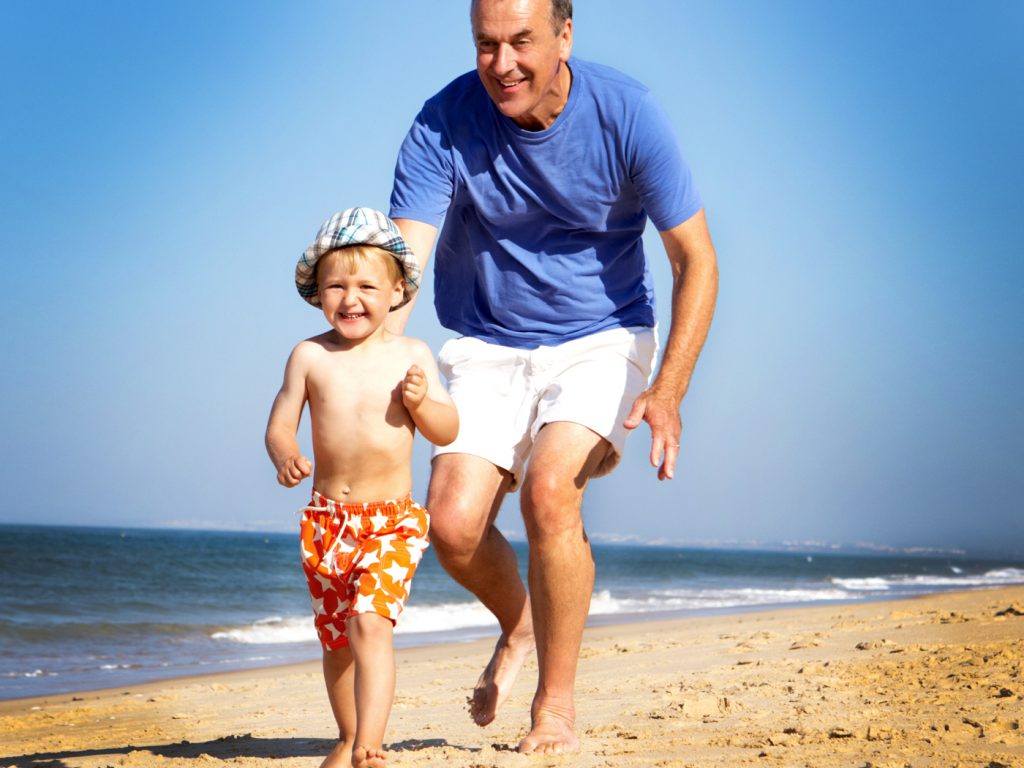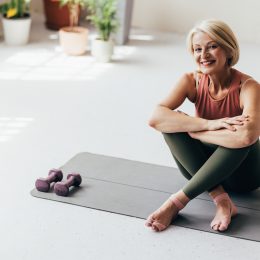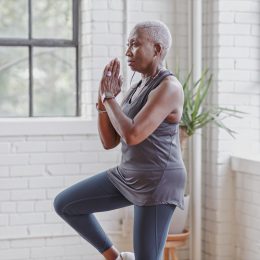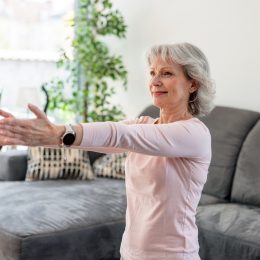The Best Way to Improve Mobility
For joints that move well, traditional stretching isn’t enough. Focus on these movements instead.

There’s a picture that surprises me every time I see it: An elderly woman, who appears to be dressed for a game of shuffleboard, stands on her left leg and stretches her right against a signpost in front of her until it’s pointing straight up, directly toward the sky.
When I show it to my teenage daughter, who’s been studying ballet since she was 5, she isn’t impressed. “It’s a trick,” she tells me. “Both knees are bent, and she’s leaning backward.” As any dancer knows, she adds, your flexibility is only as good as your ability to control your own movements without cheating.
I think about that picture, and my daughter’s cold-eyed analysis (she doesn’t give the woman any slack because of her age), every time I walk into my gym’s warmup area and see older adults stretching their hamstrings while lying on their backs and using a strap to pull their leg into position. It looks like a useful exercise. But is it?
“I don’t think it improves hamstring flexibility,” says Shon Grosse, M.P.T., a physical therapist and owner of Comprehensive Physical Therapy and Fitness in Colmar, Pennsylvania. More importantly, he adds, “It doesn’t help functional mobility.”
Flexibility Versus Mobility
The difference is important. Flexibility refers to the length of a muscle in isolation. Mobility describes how well your joints actually move. When you have limited mobility in key joints, like your hips, other joints will move more than they should. That, Grosse explains, leads to a lot of the back and knee problems he sees.
Which leads us to another four-syllable word: stability. A stable lower back allows your hips to achieve their full range of motion, which in turn protects your knees from excess side-to-side or rotational movement.
For the best combination of mobility and stability, Grosse recommends two strategies and four key exercises.
As always, safety comes first. The exercises shown here may be different or more advanced than those you’ll experience in a SilverSneakers class. If you’re unsure if they’re right for you, talk to your doctor.
Strategy #1: Warm Up Smartly
If you work out for an hour, Grosse recommends warming up for the first 15 minutes. A good warmup should include:
- Some general activity—like walking or jogging on a treadmill or pedaling a stationary bike—to raise your core temperature. With a warmer body, you’ll have less friction in your joints.
- Movements like the ones below to establish an appropriate combination of mobility and stability in your shoulders, back, and hips. (I typically include all four exercises below in my warmup, but you can do them whenever is best for your body.)
- One or two warmup sets with relatively light resistance for the first exercise in your workout.
Strategy #2: Do Total-Body Workouts
A good workout includes exercises that work all your major joints through an appropriate range of motion while also stabilizing the joints that aren’t supposed to move. Squats, lunges, presses, rows, and pulldowns are all good examples.
Assuming your doctor hasn’t advised against it and that your knees can handle it, the walking lunge may be the single best mobility exercise, Grosse says. You mobilize your hips, knees, and ankles; stabilize your shoulders and core; and challenge your balance by moving forward.
Whichever exercises make up your warmup and strength routine, these four movements make great additions.
Exercise #1: Glute Bridge
It’s a simple exercise that works your glutes, which are crucial for core stability, while sparing your lower back.
Lie on your back with your knees bent and feet flat on the floor. Lift your hips until your body forms a straight line from knees to chest. Pause for 10 seconds, feeling a full contraction in your glutes. Lower your hips and repeat. Do five to six reps.
Exercise #2: McGill Curlup
This exercise, developed by back specialist Stuart McGill, Ph.D., improves on the traditional crunch by strengthening your abdominal muscles without straining your back or neck.
Subscribe to our newsletter
It's quick and easy. You could be one of the 13 million people who are eligible.
Already a member? Click to discover our 15,000+ participating locations.
Follow Us
Lie on your back with your right leg extended straight on the floor and your left leg bent with foot flat on the floor. Set your hands, palms down, between your lower back and the floor. Raise your elbows off the floor.
Now comes the tricky part: Raise your head slightly off the floor while keeping your neck aligned with your torso. McGill says to imagine your head resting on a digital scale that’s even with the floor. Raise your head just enough for the scale to register 0. You should feel your abs working hard. Hold for 10 seconds, lower your head and elbows, and repeat. Do two to three reps. You can switch legs if you want, although it’s not necessary.
Exercise #3: Romanian Deadlift
Grosse considers this hip-hinge exercise the best alternative to stretching your hamstrings with one leg in the air. Because it’s “loaded”—you’re holding light weights in your hands—it improves hip mobility along with hamstring flexibility.
Stand holding a light barbell or dumbbells in front of your thighs. Keeping your back flat and hands close to legs, push your hips back as you lower the weights to your knees or just below. Hold for a second or two, straighten your hips, and repeat.
Exercise #4: Plate Press
The shoulders, like the hips, operate in several planes of motion: forward and back, up and down, out and in. The plate press, Grosse says, utilizes all three with a load in your hand.
Sit on a bench or sturdy chair holding a light plate in your right hand. If you’re doing this at home, you can use a book instead of a plate. With your arm in front of you, position your upper arm so it’s parallel to the floor, elbow bent and pointing forward, and forearm angled back toward your shoulder.
Press the weight straight up until your arm is straight and aligned with your neck and torso. Be sure not to let your arm go behind your neck and torso. Your upper arm will naturally rotate so your elbow joint points to the outside at the top of the movement. Lower your arm. Do four to five reps, then switch sides and repeat.





